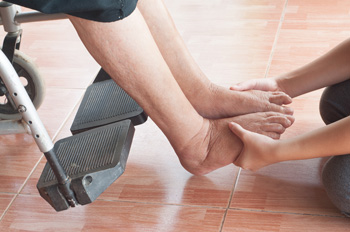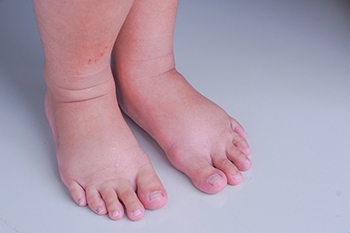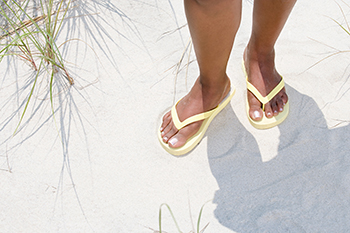Items filtered by date: August 2022
Feet Problems in the Elderly

The foot can be compared to a tire of a car. After many years of use, a foot can wear down like tires wear down. A tire becomes thin and the tread less dependable over time just as a human foot shows its age over time. The key difference between a foot and a tire is the former cannot be changed. We get one pair of feet per life. Because seniors are generally less active than those younger, they may not pay as much attention to their feet as they once did. But as one ages, they need to pay even more attention to their feet. If you are a senior you will likely experience foot pain. And foot pain is highly associated with a higher risk of recurrent falls, reduced mobility, and a loss of independence. Muscles and tendons lose elasticity with age and that contributes to pain. Additionally elderly foot pain is a result of putting on weight, losing fat on the padding of feet, compromised blood flow from health problems (such as diabetes or peripheral neuropathy), persistent foot problems, such as hammertoes, bunions, corns, calluses, wearing shoes that do not fit well, or simple neglect in care. Daily foot inspections, washing, drying, and moisturizing feet frequently, and cutting toenails straight across are all part of a good foot care routine. Paying attention to diet, exercising, and wearing properly fitted shoes and socks will all help in alleviating foot problems as well. If you are a senior or responsible for caring for a senior, include a podiatrist on the health care team to teach you how to care for your feet or provide diagnosis and treatment should a problem arise.
Proper foot care is something many older adults forget to consider. If you have any concerns about your feet and ankles, contact Amir Shalev, DPM from Complete Foot & Ankle Care. Our doctor can provide the care you need to keep you pain-free and on your feet.
The Elderly and Their Feet
As we age we start to notice many changes in our body, but the elder population may not notice them right away. Medical conditions may prevent the elderly to take notice of their foot health right away. Poor vision is a lead contributor to not taking action for the elderly.
Common Conditions
- Neuropathy – can reduce feeling in the feet and can hide many life-threatening medical conditions.
- Reduced flexibility – prevents the ability of proper toenail trimming, and foot cleaning. If left untreated, it may lead to further medical issues.
- Foot sores – amongst the older population can be serious before they are discovered. Some of the problematic conditions they may face are:
- Gouging toenails affecting nearby toe
- Shoes that don’t fit properly
- Pressure sores
- Loss of circulation in legs & feet
- Edema & swelling of feet and ankles
Susceptible Infections
Diabetes and poor circulation can cause general loss of sensitivity over the years, turning a simple cut into a serious issue.
If you have any questions please feel free to contact our office located in Las Vegas, NV . We offer the newest diagnostic and treatment technologies for all your foot and ankle needs.
It's Time for Beautiful Feet
Obesity and Ankle Sprains

Individuals who struggle with obesity are sometimes more susceptible to experiencing problematic foot conditions. For example, some obese individuals are more likely to develop flat feet because their higher body weight makes them exert more pressure on their feet when standing. Therefore, if you suffer from obesity, it might be a good idea to take extra care of the health of your feet. Obese individuals ought to be particularly mindful of ankle sprains because not only does obesity increase your risk of spraining the ankle, it also might make recovery from such an injury more difficult and prolonged. Ankle sprains occur when the foot turns awkwardly and tears or strains the ligaments surrounding the ankle. Obesity also heightens your risk of developing a sprained ankle because the extra body weight increases your instability and reduces balance control, among other things. When recovering from an ankle sprain, obese individuals are also particularly vulnerable. The joints affected by an ankle sprain may take a longer time to heal post-injury in obese individuals because of the detrimental effects obesity has on ankle joint function. Therefore, if you are obese and are trying to recover from an ankle sprain, you might need extra help in managing your symptoms to heal the injury. Contact a podiatrist for any questions you might have about how obesity affects ankle sprains.
Obesity has become very problematic at this point in time and can have extremely negative effects on the feet. If you’re an obese individual and are concerned about your feet, contact Amir Shalev, DPM from Complete Foot & Ankle Care. Our doctor can provide the care you need to keep you pain-free and on your feet.
Obesity and Your Feet
Since your feet are what support your entire weight when standing, any additional weight can result in pain and swelling. Being overweight is one of the main contributors to foot complications.
Problems & Complications
Extra Weight – Even putting on just a few extra pounds could create serious complications for your feet. As your weight increases, your balance and body will shift, creating new stresses on your feet. This uneven weight distribution can cause pain, even while doing the simplest tasks, such as walking.
Diabetes – People who are overweight are at serious risk of developing type-2 diabetes, which has a drastic impact on the health of your feet. As you get older, your diabetes might worsen, which could lead to loss of feeling in your feet, sores, and bruises. You could also become more prone to various infections.
Plantar fasciitis – Pressure and stress that is placed on muscles, joints, and tendons can trigger plantar fasciitis, which is an inflammation of tissue that forms along the bottom of the foot.
If you have any questions please feel free to contact our office located in Las Vegas, NV . We offer the newest diagnostic and treatment technologies for all your foot and ankle needs.
Various Reasons Why Toe Pain May Occur

Pain in the big toe can be the result of a foot injury, an existing physical condition, or it may indicate there are underlying medical issues. This type of toe pain can accompany arthritis, gout, and specific types of fractures. Pain from arthritis can consist of difficulty in moving the big toe, and there may be swelling near the joint in the big toe. Relief may come from changing the shoes that are worn, and in severe cases, surgery may be a necessary option. People who develop ingrown toenails often have pain in their big toe. It happens when the nail grows into the skin, instead of over it. This ailment can cause extreme pain and discomfort, and surgery is often necessary for permanent relief. The foot condition that is referred to as gout typically affects the big toe. It happens as a result of a buildup of uric acid in the blood, and can form crystals that lodge in the joints of the big toe. The pain can be debilitating, and in severe cases, many patients are unable to walk or stand. Toe pain can be difficult to live with, and if you have this type of pain, it is strongly suggested that you are under the care of a podiatrist who can help you to manage this condition.
Toe pain can disrupt your daily activities. If you have any concerns, contact Amir Shalev, DPM of Complete Foot & Ankle Care. Our doctor can provide the care you need to keep you pain-free and on your feet.
What Causes Toe Pain?
Most severe toe pain is caused due to a sports injury, trauma from dropping something heavy on the toe, or bumping into something rigid. Other problems can develop over time for various reasons.
Toe pain can be caused by one or more ailments. The most common include:
- Trauma
- Sports injury
- Wearing shoes that are too tight
- Arthritis
- Gout
- Corns and calluses
- Hammertoe
- Bunions
- Blisters
- Ingrown toenails
- Sprains
- Fractures (broken bones)
- Dislocations
When to See a Podiatrist
- Severe pain
- Persistent pain that lasts more than a week
- Signs of infection
- Continued swelling
- Pain that prevents walking
Diagnosis
In many cases the cause of toe pain is obvious, but in others, a podiatrist may want to use more advanced methods to determine the problem. These can range from simple visual inspections and sensation tests to X-rays and MRI scans. Prior medical history, family medical history, and any recent physical traumatic events will all be taken into consideration for a proper diagnosis.
Treatment
Treatments for toe pain and injuries vary and may include shoe inserts, padding, taping, medicines, injections, and in some cases, surgery. If you believe that you have broken a toe, please see a podiatrist as soon as possible.
If you have any questions please feel free to contact our office located in Las Vegas, NV . We offer the newest diagnostic tools and technology to treat your foot and ankle needs.
Causes and Treatment of Swollen Feet

Swelling, called edema, generally occurs when fluid collects in the tissues, commonly in the feet. A number of conditions may lead to edema, including standing for too long, wearing shoes that do not fit properly, eating certain types of food, and various medical conditions. Swollen feet are particularly common among pregnant women, diabetics, and people with heart or circulatory problems. Aging, nutritional deficiencies, and premenstrual syndrome are other factors. A number of easy, at-home remedies can reduce the swelling in your feet. Among them are drinking plenty of water, reducing salt intake, keeping your feet elevated, wearing shoes that fit correctly, and wearing compression socks. Losing weight, eating more foods with potassium, and massaging your feet are other helpful remedies. If the edema in your feet and ankles becomes chronic, especially if you have an underlying health condition such as diabetes or heart disease, it is a good idea to see a podiatrist for a complete examination and appropriate treatment options.
Swollen feet can be a sign of an underlying condition. If you have any concerns, contact Amir Shalev, DPM of Complete Foot & Ankle Care. Our doctor can provide the care you need to keep you pain-free and on your feet.
Swollen feet are a common ailment among pregnant women and people who stand or sit for extended periods. Aging may increase the possibility of swollen feet and patients who are obese often notice when their feet are swelling too. There may be medical reasons why swollen feet occur:
- Phlebitis - A condition that causes the veins to become inflamed and can also cause leg pain.
- Liver disease - This may lead to low blood levels of albumin which is a protein. This can cause fluid in the blood to pass into the tissues and several areas of the body can become swollen.
- Heart failure - When the heart doesn’t pump properly the blood that is normally pumped back to the heart can pool in the veins of the legs causing swollen feet.
- Kidney disease - One of the main functions of the kidneys is releasing excess fluid in the body. This type of condition can make it difficult for the kidneys to function properly, and as a result the feet may become swollen.
- Deep-vein thrombosis (DVT)- This is a serious condition where blood clots form in the veins of the legs. They can block the return of blood from the legs to the heart which may cause the feet to swell. It is important to be treated by a podiatrist if this condition is present.
Swollen feet can also be caused by bone and tendon conditions, including fractures, arthritis, and tendinitis. Additionally, there may be skin and toenail conditions and an infection may cause the feet to swell. Patients who take medicine to treat high blood pressure may be prone to getting swollen feet.
Many patients elevate their feet to help relieve the swelling and this is generally a temporary remedy. When a podiatrist is consulted the reason behind the swelling can be uncovered and subsequently treated.
If you have any questions please feel free to contact our office located in Las Vegas, NV . We offer the newest diagnostic tools and technology to treat your foot and ankle needs.
Flip Flops May Have Negative Effects on the Feet

Many people choose to wear flip flops in the warmer months because of the many styles to choose from and their simplicity to wear. However, wearing flip flops can be harmful to the feet. Some of the ways the feet can be negatively affected include having a different gait, or walking style, and the toes can cramp from trying to keep the shoe on the foot. Additionally, the skin on the heels can become dry and cracked from frequently wearing this backless shoe, and the ankles may start to point inward. They typically do not provide any type of arch support, and if these types of shoes must be worn, it is suggested that they be worn for short periods of time. They are appropriate to wear to the beach, but are frowned upon if worn all day. If you would like additional information about how wearing flip flops can affect the feet, please speak with a podiatrist who can address any concerns you may have.
Flip-flops are not always the best choice of footwear. If you have any concerns about your feet or ankles, contact Amir Shalev, DPM from Complete Foot & Ankle Care. Our doctor will assist you with all of your foot and ankle needs.
Flip-Flops and Feet
When the weather starts warming up, people enjoy wearing flip-flops. Flip-flops are comfortable, stylish, and easy to slip on and off; they're perfect for any summer beach goer. However, these shoes can cause harm to the feet.
How Can Flip-Flops Affect Me Long-Term?
- Ankle problems
- Hip problems
- Lower back problems
- Pain in the balls of the feet
- Problems with foot arches
- Changes in the way you walk
Are There Injuries Associated with Flip-Flops?
Yes. Since flip-flops are relatively weak and do not provide the same amount of support as sneakers, people who wear flip-flops regularly are more susceptible to injuries. On top of that, the open nature of the shoe makes your feet more prone to other problems, such as cuts and even infections. Common injuries and ailments include:
- Sprained ankles
- Blisters
- Infections
- Cuts and Scrapes
I like Wearing Flip-Flops. Are There Safe Alternatives?
When buying flip-flops, try to find ones that have sturdy soles and that are made of high-quality materials that will support for your feet. These flip-flops will cost more but will also last longer as a result.
If you have any questions please feel free to contact our office located in Las Vegas, NV . We offer the newest diagnostic and treatment technologies for all your foot and ankle needs.

